Why Ronaldo is giving Solskjaer a huge tactical problem

In one sense, Manchester United’s 4-2 defeat by Leicester could be considered something of a freak result.
The scoreline was 1-1 for the majority of the game, both sides significantly overperformed their xG, and four of the game’s six goals came in the frenetic final 12 minutes — three of them scored by Leicester. It was one of those brilliant periods where strategy and tactics go out of the window, giving way to chaos and luck.
In another sense, Leicester running out convincing winners fitted the game’s pattern. Brendan Rodgers’ side were more organised without possession and more purposeful with the ball. In both aspects of the game, they were considerably more cohesive than Manchester United, who are based around individualism, and are weaker than the sum of their parts.
The poster boy for their current malaise, of course, is Cristiano Ronaldo. He is 36 and, in stark contrast to title rivals whose forwards press relentlessly, Ronaldo simply doesn’t have the physical capacity to repeatedly press — or really, to press at all. The fact he was bottom of these figures — taken from the beginning of the month — came as a surprise to no one.

The extent to which he was bottom, however — pressing half as much as the next least-active player — does summarise the degree to which manager and team-mates must reshape to cope.
Manchester United knew the deal when signing Ronaldo: they would get little out of him in terms of regaining possession, but would be sure of a goal per game or pretty close to it. Ronaldo has largely kept to his side of the deal. He has averaged a goal every 111 minutes, none of them penalties. If he had taken and scored United’s late penalty against Aston Villa, he’d be pretty much bang on a goal per game.
His previous Manchester United, Real Madrid, Juventus and Portugal sides have been, to varying extents, structured to cover for him. If he played on the left, the opposite winger would tuck inside more. If he played up front, the wide players or No 10 would play deeper than they would have expected. When Ronaldo leaves, others — Wayne Rooney, Karim Benzema — go up a level because they’re no longer playing second fiddle.
But Manchester United are not successfully covering for him. Without possession they are neither one thing nor the other — they don’t drop off successfully and form a compact block, and they don’t press. The consequence is that the opposition easily play through them.
Here’s what happened when United dropped off against Leicester.
The first time you see a Leicester pass arrowed through United’s midfield to a man in space, like this one from Boubakary Soumare towards Kelechi Iheanacho, you think it might just be a one-off example of good attacking play.

After the second, from Youri Tielemans to James Maddison, you question whether Manchester United’s holding midfield duo of Nemanja Matic and Paul Pogba are positioned correctly.
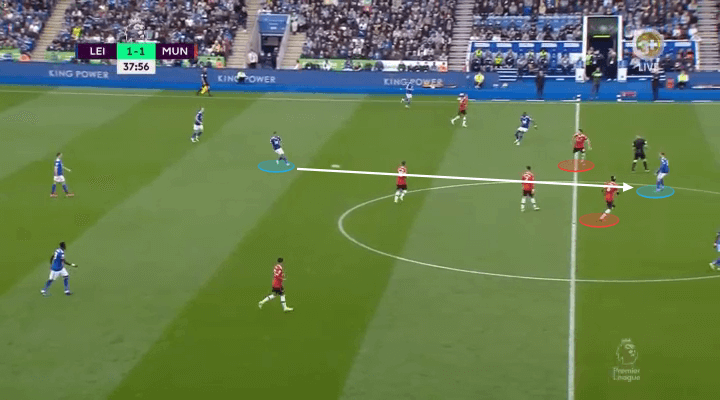
For the third time — Maddison to Tielemans — you consider the positions of the wide players, vaguely in pressing positions but without the side applying any pressure to the man on the ball, and start to feel sympathy for Matic and Pogba, being forced to cover so much lateral space.

And then when Tielemans receives the ball and spins, you realise the extent of the gap between midfield and defence, and that Matic and Pogba are being forced to cover so much ground vertically, too.

And here’s what happens when United pressed.
It’s not clear if Ronaldo is trying to press himself in this position, but he glances behind him and gestures for Mason Greenwood to push forward and shut down Caglar Soyuncu.
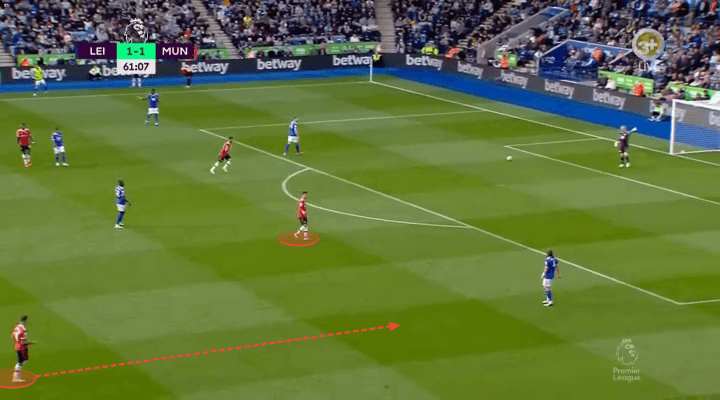
Greenwood does as he’s told, but there’s no actual tactic in his pressing here — he’s not cutting off any passing angles. If he was in a more organised side, he might bend his run to block off the passing lane into Leicester’s left wing-back Timothy Castagne, but he just ambles straight towards Soyuncu…
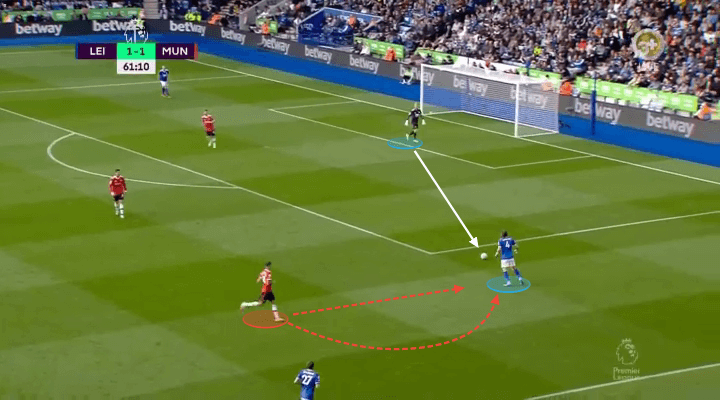
…which means the defender can easily turn and play a simple ball to Castagne. There’s no United player backing up the initial press…
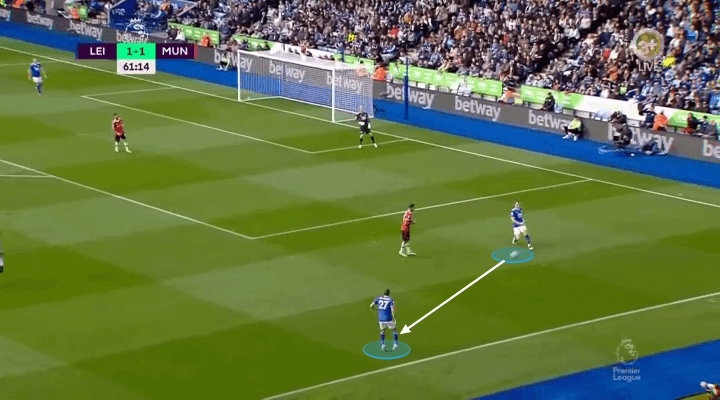
…so Castagne can dribble forward into space. Ronaldo now feels obliged to drop back and shut him down, but Castagne simply passes inside to a free midfielder, and Leicester can build from the centre of the pitch. The press was that easy to break.

In stark contrast, when a Leicester forward started a press, the whole team backed him up. Their first goal, Tielemans’ delicious chip, came when Iheanacho intercepted a David de Gea pass to Harry Maguire. That was an extreme example but it was also typical of Leicester’s approach. Here, when Jamie Vardy moves towards Victor Lindelof, he starts a press that involves five players — everyone on the left half of Leicester’s system…

…and it’s the fifth man, Soyuncu, who makes the interception as a Bruno Fernandes pass goes astray.

The shape without the ball just isn’t what you expect of a Premier League side. United’s 4-2-3-1 often looks more like 4-2-4. Here’s one example of them in a midfield block, with Jadon Sancho trying to start a press. They just look easy to play through — so many gaps around individuals.

A comparison with Leicester’s shape doesn’t quite make sense — they were using 3-4-1-2. But a contrast with Rafa Benitez’s Everton, their previous opponents, does. Here, there’s organisation within the individual lines, and cohesion between them — note how close the defence and midfield are together.
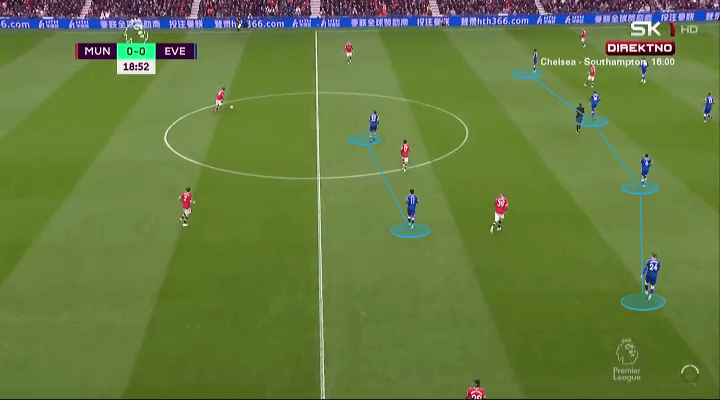
United’s starting XI is impressive in terms of individuals, but poor in terms of partnerships and balance. In the central attacking duo, Fernandes is now being forced to do more running without possession to compensate for Ronaldo. He’s largely getting through this manfully, but Fernandes is expending a lot of energy and is less able to focus on what happens when the ball comes his way. Considering his sensational performances since signing for United, the side should continue to be based around him. Ronaldo’s signing has inevitably changed the situation, and United’s best player now finds his game compromised.
They might get away with things if they had a disciplined wide duo to keep the midfield solid. But Sancho is an extremely attack-minded winger, more attacker than midfielder. He’s accustomed to a Dortmund side that tried to press cohesively — he’s still putting himself in those positions rather than helping out United’s midfielders.
On the other flank, Mason Greenwood is a similarly attacking player. He started as a centre-forward in two of United’s first three games of the season, scoring in both, and that seemed likely to be his primary position this season. Ronaldo’s arrival has inevitably changed that, and while he can still score from wide — his goal here was outstanding — he can’t be expected to suddenly be a Park Ji-sung without the ball.
The central midfield zone has the same old problems. We’ve known for years that Pogba is poor defensively when playing in a central midfield duo. Solskjaer worked that out, preferred to use him from wide, and he started the season in excellent form there. But now Ronaldo has to play as a striker, which means Greenwood is playing out wide, which means Pogba has been shifted inside again. So United’s central midfield problems stem from Ronaldo.
“Over the international break we have had a good look to see what has gone wrong lately,” said Solskjaer after yesterday’s defeat. “But we need to look at the whole set-up and balance of the team and maybe something has to give.”
But it’s difficult to see what the solution is. Solskjaer feels like a Galactico-era Real Madrid manager, compelled to start certain players because of their reputation, and largely in a job because he’s happy to placate them rather than make tough tactical decisions. Omitting Ronaldo or Fernandes feels impossible, he can’t be seen to be wasting the £73 million Sancho, Greenwood deserves to start based on form and Pogba started the season brilliantly. But these five can’t play together. To complicate matters further, Anthony Martial started against Everton and scored United’s only goal, and Marcus Rashford came off the bench this weekend to briefly make it 2-2. Oh, and remember Edinson Cavani?
This all felt entirely predictable after Ronaldo’s arrival. Whether he should contribute more without possession is debatable, but it seems obvious that his presence has caused a tactical conundrum that Solskjaer might not be able to solve.

 180
180 